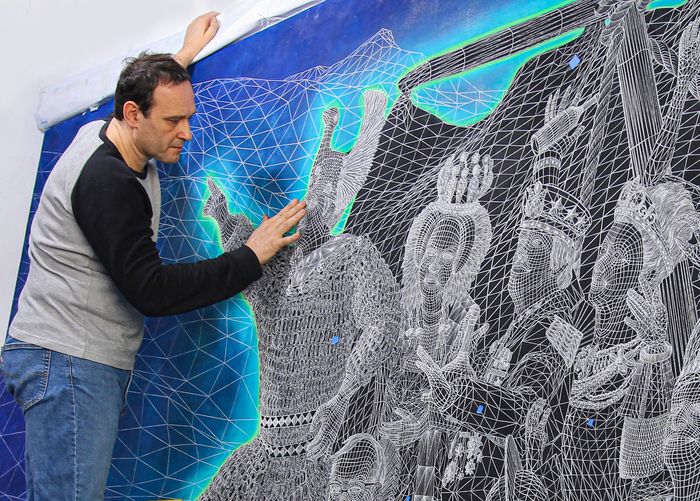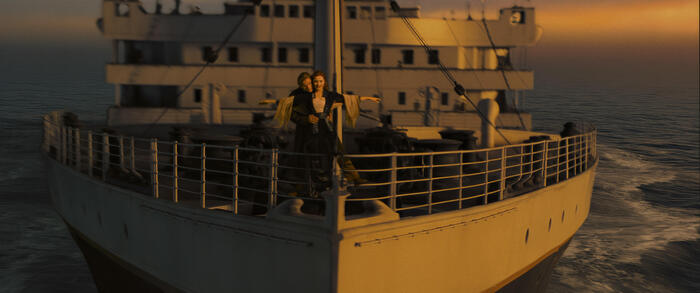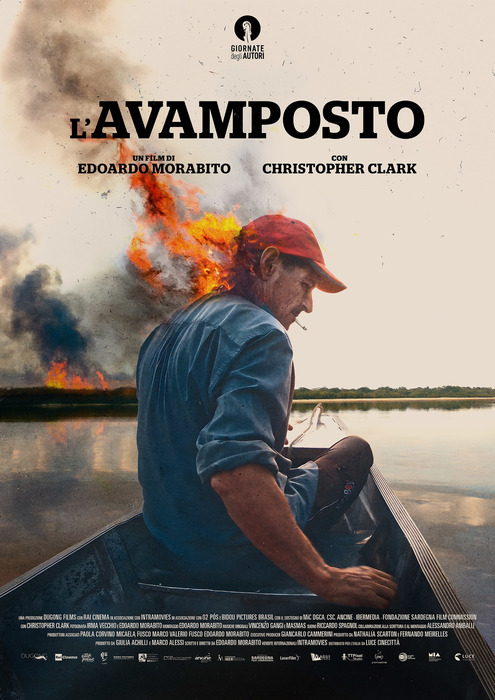Werner Herzog during the filming of 'Fitzcarraldo' in Peru.Getty
Werner Herzog has always conceived of cinema as a high-risk sport.
In his opinion, if you haven't risked your skin making your film, it is most likely not worth it.
"The cinema has given me and taken everything," said the German director on one occasion.
"It has made my dreams come true and given me a solid reason to live, but it has also ruined, exhausted, unhinged and endangered."
Born in Munich in 1942, Herzog grew up in the Bavarian mountains, in a home without a radio, telephone or television.
He did not set foot in a cinema until he was 16 years old.
Very shortly after, at 19, he began filming his first short films, a cinematic guerrilla war financed by what little he could save by working a factory night shift welder.
In 1972 he became one of the great references of the new German cinema with
Aguirre, the wrath of God
, an enigmatic, intense and devastating film like few others, which was filmed at the highest point in the Amazon jungle and in the Peruvian Eastern Cordillera.
That was already an experience at the limits of sanity, the kind that jeopardizes the integrity of almost everyone involved.
Now 40 years ago, during the filming of what may be his masterpiece,
Fitzcarraldo
(which would not be released until 1982), Herzog was about to throw in the towel.
For the first time in his career, it seemed that one of his movie dreams was not going to be able to materialize.
The filmmaker had conceived a grandiose scene, an act of unprecedented excess: dragging a 320-ton steamboat to the top of a 500-meter hill and, from there, lower it over the waters of a tributary of the Amazon.
That image, sensed a year earlier while navigating the Marañón river basin, very close to the border between Peru and Ecuador, has haunted him ever since.
I wanted to make it come true, show it to the world, "but without models, special effects or cheap cinematographic illusionism."
The jungle law
That film was intended to be a hymn to excess, a tribute to the delirious life of Carlos Fermín Fitzcarrald, a late 19th-century Peruvian rubber merchant who set out to build an opera house in the jungle city of Iquitos.
Herzog felt that he needed to become infected with that spirit and that there was also something absurd and excessive in his filming: “The audience is not going to settle for a substitute this time.
I need you to know that what you are seeing is real, that the ship is really climbing to the top of the mountain.
Only then will I get them to regain confidence in what their own eyes show them ”.
However, in the last months of 1980, after the camp he had set up in the remote village of Wawaim was raided by indigenous activists of the Aguaruna ethnic group, the director was carried away by the deepest discouragement.
By then he had already spent about a million dollars from his own production company and had lost the financial support of Fox, which did not understand his obstinacy in wasting time and money on a scene that they considered expendable.
In
Conquista de lo inutil
(Blackie Books, 2014), a logbook that has gone down in history as one of the most insane shootings in the history of cinema, Herzog acknowledges that he hit rock bottom one afternoon when he arrived at his apartment in Iquitos and discover that a termite infestation had eaten his clothes, his books and his production notes.
This was a sign.
The stars conspired against his film.
It was time to lower the flag.
Never has the most indomitable of filmmakers come this close to giving up.
Herzog had been in the jungle for more than a year, searching for filming locations, feeding on grilled monkey and alligator meat, suffering violent fevers and diarrhea, harassed by rats, tarantulas and bats, eaten by bed bugs, mosquitoes and red ants.
He hadn't started filming yet and was already broke and at the limit of his physical and mental stamina.
His friend Francis Ford Coppola, in whose San Francisco mansion he had written the screenplay for the film a year and a half earlier, even told him that this shoot was going to be worse than
Apocalypse Now
, that the project was getting out of hand. .
But Herzog clung to the cinema.
He bet on adventure and overcame his moment of weakness, convinced as he was that "stopping dreaming is equivalent to being dead."
He gave up filming in northern Peru, where a border conflict was brewing against Ecuador, and set up a new camp, this time located much further south, near Cuzco, in the Camisea river basin.
There, he suffered a strike and harassment from the Peruvian tabloid press, which unfoundedly accused him of drug and arms trafficking.
On this occasion, however, he managed to gain the complicity of local indigenous communities, natives who alternated machetes and loincloths with John Travolta T-shirts and who were willing to work on the film.
They did not even blink when Herzog showed them the huge steam barge he intended to take over the top of the hill using a very complex but crude-looking system of pulleys and rails.
Fear and disgust in Camisea
Finally, on January 6, 1981, filming itself began.
A few days before, the three actors who were to star in the film had arrived at the camp on the banks of the Camisea: Jason Robards, Mick Jagger and Mario Adorf.
The Rolling Stones singer had an enthusiastic and caring attitude from day one.
He even volunteered to be a chauffeur for the production team.
Herzog remembers how his luxury sports car got stuck over and over again in the mud on the riverside forest tracks without Jagger losing his smile.
Robards and Adorf, on the other hand, behaved, in the director's opinion, like "a couple of egotists and pompous cowards."
Robards, who was 58 years old at the time and was going to play the role of Fitzcarraldo, tolerated daily life very badly in those barracks lost in the middle of the jungle.
The heat, humidity and coexistence with "vermin and indigenous people" became unbearable.
Adorf made common cause with him by forcing Hezog into exercises in persuasion and diplomacy to which he was not used.
Meanwhile, the main actress, Claudia Cardinale, got bored at her hotel in Iquitos and insisted over and over again on going to Camisea to be with the rest of the team, even if it was sleeping in a hammock under a tree.
In February, Robards fell ill with dysentery.
He took the first flight to Los Angeles and never returned.
Filming was interrupted for several weeks until the deadline for Jagger to join the Rolling Stones world tour: “I'm so sorry, Werner, but I have to go.
If you're still in the jungle a year from now, call me ”.
That seemed, once again, the end of the road.
A legendary enmity
Herzog traveled to New York in a desperate attempt to save the film, which had to be re-shot almost entirely due to the impossibility of having the material in which Robards appeared.
There he took the opportunity to meet one of the key characters in his career and life, Klaus Kinski, the actor who had starred in two of his most famous films,
Aguirre, the wrath of God
and
Nosferatu, the vampire of the night
.
Kinski was, in Herzog's opinion, a performer of enormous talent, but also "a narcissistic despot and a dangerous madman", one of the people who had made him suffer the most in his entire career.
His was a love-hate relationship that today is part of the great mythology of cinema.
The afternoon they met in New York, Kinski was sober and collected.
For the first time in a long time, the director and interpreter were able to have a cordial conversation.
They even talked about the short time they had been together in a pension in Munich, when Herzog was 13 years old and living with his mother.
Kinski was then a 30-year-old unemployed actor and suffered frequent attacks of rage during which he would lock himself in the bathroom he shared with the rest of the guests and smear the walls with blood and excrement, but it is unlikely that those sordid details came up in the laid back New York Winter Talk of 1981.
The fact is that, a few days later, blinded by the placidity with which the meeting had passed, Herzog proposed to Kinski that he travel with him to the Peruvian jungle and star in the film.
Kinski accepted.
His presence in the cast made German public television more willing to participate in the project.
Thus began the second phase of filming, the decisive one, with Kinski already in the shoes of Fitzcarraldo, a character whose folly and excess were for him like a tailored suit.
In this final stretch, Herzog's fascinating logbook runs over, loses consistency and borders on delirium.
In mid-April, shortly before the scene of the steamer that climbs the top of the hill finally shoots, the most famous of the violent altercations between Herzog and his fetish actor takes place.
The director himself tells it in detail in the documentary
My intimate enemy
and filmmaker Les Blank filmed it in his documentary
Burden of Dreams
, a fascinating visual chronicle of the ins and outs of that Amazonian adventure.
Kinski accuses Herzog of being a criminal, tyrant, and insane while the director tries to ignore him.
Extras and technicians contemplate the scene with stupor and impatience, fed up with the hysteria and the continuous outbursts of that German demon referred to as "the madman with white hair."
The dead had a price
A few days later, in mid-May, the scene repeats itself.
Kinski freaks out again, insults everyone, interrupts the shoot with his dire rage and whims.
Two local caciques who act as extras in the film, the one from the campas and the one from the Machiguengas, approach Herzog during a break and offer him, quite naturally, to kill the old demon "to save the movie."
We can cut its neck like a chicken, they say, and make the corpse disappear.
They will never find it.
Herzog wants to make sure you have understood correctly.
Are they talking about killing Kinski?
The idea, according to the filmmaker years later (joking, apparently, only half), was so tempting that he came to consider it for a few minutes.
In the end, he declined the offer: "No thanks, I'm afraid I need Klaus to finish the shoot."
Soon after, a disturbing scene is shot in which Kinski is forced to eat an entire bowl of dark stew under the watchful eyes of native extras, including the two who had offered to cut his throat.
In the end, in November 1981, with Kinski alive and Herzog exhausted, but still sane and still enthusiastic about the film, the dreamed overland journey of the huge barge was finally completed.
There were some serious injuries, but no deaths.
Herzog soberly describes what his feelings were at the moment he managed to complete his feat: “The ship was already indifferent to me, it was worth no more than any broken beer bottle in the mud, any steel cable twisting on the ground.
I have not felt any pain, no joy, no excitement, no relief, no happiness, I have not heard any sound or sigh of relief.
Only the awareness of having done something completely useless or, more exactly, having penetrated the depth of his mysterious realm. "
The filming of the film dedicated to an adventurer who wanted to make an absurd dream come true was itself an adventure, a delusion and an excess.
Herzog did allow himself an act of euphoria after completing the last scene of the film, the arrival of the ship at the dock in Iquitos.
He dove head first into the water and scratched his shoulder when he brushed against a metal beam hidden under the murky brown water.
Once again, true to his character, integrity was at stake in the most absurd way and was about to die in a fit of euphoria for the cinema.
Today the film is considered a classic and Herzog was rewarded for his torment with a Palme d'Or for best director at Cannes.
Years later, he would have Kinski again in another shoot that would also end up becoming an adventure, that of
Cobra Verde
(1987).
This time no one known to have offered to cut the white-haired demon's neck.
You can follow ICON on
,
,
, or subscribe here to the
Newsletter
.








/cloudfront-eu-central-1.images.arcpublishing.com/prisa/OCEVHJEFHRFUTE37TBGEDFHUCI.jpeg)



/cloudfront-eu-central-1.images.arcpublishing.com/prisa/KMEYMJKESBAZBE4MRBAM4TGHIQ.jpg)


